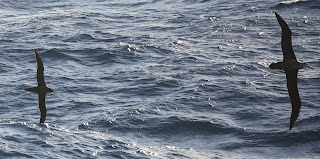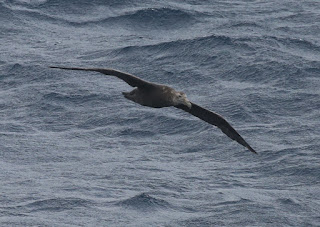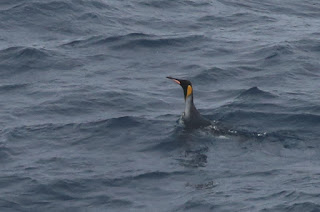OK! It is 24th January. We are out of bed & ready to go on our eagerly anticipated trip! It is still dark outside, as we set off on the drive to Cape Town International Airport. This has not been an easy trip to organize with all the covid protocols to be observed & one never knows if you are even getting on board, with the 48 hour PCR test & the pre-boarding antigen test to be passed!
Myself, Tom & Jacky.
We arrived at the airport on time, passed our car over to the parking company & walked to the shuttle bus meeting our friends from UK Tom & Jackie on the way. Lot of catching up to do & we had lots of time to do it, as the bus didn't move for an hour! A male Peregrine sat on a nearby lamp post, but didn't stay long enough for me to get my camera out!
MSC Orchestra
Finally the bus moved & we drove to the docks, our ship dominating the docklands. It was huge! Then we had to queue for our antigen test which after a short wait we passed & we were on board!
Our home for the next seven nights.
Our cabin was in a great position at the front (bow) of the ship on the port side, but it was a little small.
The iconic Table Mountain.
At last, we are setting sail!
Jos. It was nice to finally meet him
after corresponding for over a year!
While we were anchored just offshore
this very strange Sunfish was seen.
It is a very strange looking animal indeed.
Nice to see it so close.
Southern Right Whale
These animals should be in the Antarctic now.
A nice start to the trip!
We sailed out of the harbor & hove to. We had to leave early because of fast approaching high winds which would have made it impossible for a ship of this size to leave. By doing this we had left 250 guests behind! MSC hired a boat to ferry them to the ship, but still we waited, seeing valuable time tick away. Time to reflect on why we were here. This trip really is the opportunity of a lifetime to sail oceanic waters to the Prince Edward & Marion Islands. This particular bit of ocean is rarely travelled & relatively unknown bird wise. Unfortunately, we had not got permission to enter the protected zone around the islands, so the three very special ticks for everyone would have to wait for another day. However, it is a fantastic opportunity to to some pelagic birding & see some rarely seen species within South African waters.
Cory's Shearwater
Great to these this species again & up nice & close!
We headed out at around 6.30pm & started to see birds. At first it was good numbers of Great crested Terns, but as we sailed further out into the sea a few Arctic Skuas & five Sabine's Gulls were seen, Then it was the time of Shearwaters to take over, Cory's Shearwater being the most numerous with 34, but also 7 Sooty & 2 Manx Shearwaters were noted.
White chinned Petrel
Around 20 White chinned Petrels also put in an appearance & these were to be an ever present throughout the voyage.
It was an excited crowd that had dinner that evening, everyone eager to see what the morning would bring.
Dawn!

Morning of 25th January & we are here!
Basically the middle of nowhere!
Heading south east.
Indian Yellow nosed Albatross
Cory's Shearwater
White chinned Petrel
Great winged Petrel
This species turned out to be common
throughout this voyage.
It is amazing how their body shape
can apparently change.
Exciting to see this species in
good numbers again.
We were both up early on 25th January, it was cool & windy but surprisingly not cold. There wasn't much variety over the sea but quality was on offer! The first Albatrosses of the trip: 6 Indian Yellow nosed Albatross & a White capped (Shy) Albatross sailed by. There were also both Great winged & White chinned Petrels. 118 Cory's Shearwaters were feeding nearby which was quite a spectacle.
Birding from the ship. I am on the left.
Around 1,400 birders were on the voyage.
White capped Albatross
Also known as Shy Albatross in South Africa,
Most are of the race Thalassarche steadi
This race migrates from its breeding grounds
in the Aukland islands off New Zealand
to the southern Indian Ocean.
Quite a migration!
Northern Giant Petrel
Cory's Shearwater
This species breeds from Portugal,
the Canary Islands & the Azores.
Migrating south in the eastern Atlantic Ocean
to areas of SW Africa with lesser numbers
into the southern Indian Ocean
Sub-antarctic (Brown) Skua
This race mainly winters in the south Atlantic
& southern Indian Oceans.
Slightly later in the morning we passed a fishing trawler with birds all around but we didn't stop to investigate fully! A casual assessment was: 54 White capped Albatross; Northern Giant Petrel; 13 Great winged Petrel;11 White chinned Petrel; 152 Cory's Shearwater & the first of several Sub-antarctic Skuas for the day.
Delana, birding from our balcony.
Atlantic Yellow nosed Albatross
As we forged further away from land, we enjoyed a scattering of Indian Yellow nosed Albatross, with an Atlantic Yellow nosed also been seen. Great winged Petrels became ever present with over 50 being recorded & the first Soft plumaged Petrels were spotted. It was a good first day out on the ocean.
Wandering Albatross
Always fantastic to see this species!
Juvenile
This juvenile will not return to land
for the next eight years!
Soft Plumaged Petrel
Black bellied Storm Petrel
Dawn on 26th January was grey & very cool! There were large swells on the sea & thee birding was fantastic! The first Sooty Albatross were seen. These are fantastic birds, limited to a small band of latitude in the southern oceans. They put on quite a show for us. Also the first Wandering Albatross was seen. What a bird this is, sailing over the waves in an effortless fashion. We were to see lots more later in the trip. Plenty of both Soft Plumaged & Great winged Petrels were around with the obligatory White chinned Petrels. Four Long tailed Skuas sat on the rough sea, but soon made themselves scarce. Three Black bellied Storm Petrels were noted. Always a difficult species to get to grips with in rough sea.
Later on in the morning it was Prions which were everywhere! They were passing in their thousands! Exciting but a little frustrating as well. The vast majority were Salvin's Prions but with small numbers (around 50) of Broad billed Prions as well. Some of these Broad billed Prions had larger bill than others! Tom managed to photograph a Slender billed Prion but I missed it. This is slightly out of range but Prion distribution is not perfectly known at present.
Little Shearwater
As always this species is very skittish at sea,
rarely allowing a close approach.
It is amazing how the light can affect
upperpart coloration.
By noon, most of the Prions had passed, but good numbers of sea birds were still around, including my first Little Shearwaters for many years. Wandering Albatrosses still graced the waves, with both a Wilson's & a Black bellied Storm Petrel being seen. later over 35 Soft Plumaged Petrels were around & a total of over 12 Little Shearwaters for the day. A superb days birding!
In the evening it was the bird fancy dress party!
Mrs Rockhopper Penguin
A closer look!
Dawn on THE DAY!
This was the day! 27th January & we were just 24 nautical miles off Prince Edward & Marion Islands. We couldn't go in any close as we failed to obtain the necessary permission from the South African Government, which meant no-one is going to see the three mega-ticks found there! We could just see the top of Prince Edward Island in the gloom. very frustrating! However the birding was fantastic!
Wandering Albatross
Incoming!
Indian Yellow nosed Albatross
This individual shows characteristics of
Atlantic Yellow nosed Albatross.
This would be unlikely considering
where the photo was taken.
Grey headed Albatross
Always uncommon, even within its core range.
A bit of a prize this one!
Seems to be more wary of ships
than other species.
White chinned Petrel
One of the more common petrels,
with a wide oceanic distribution.
White headed Petrel
This species is never numerous,
even in its core range.
It rarely, if ever comes close to ships.
Black bellied Storm Petrel
From above, it looks like a Wilson's,
but it wasn't, it flicked over!
Grey backed Storm Petrel
This species is really tiny!
Albatrosses were everywhere! At one stage I counted 38 Indian Yellow nosed; 29 Sooty; 37 Wandering & a superb Grey headed Albatross all in a very short space of time & many more were present. It was a tremendous spectacle. Also present were 23 Soft Plumaged Petrels, 2 White headed Petrels (unfortunately at distance); several Great winged Petrels; 6 Black bellied Storm Petrels & a nice Grey backed Storm Petrel.
Immature Wandering Albatross
One doesn't realize the immense size
of these creatures until.....
Until one sees them in comparison
with something else!
Sooty Albatross on the left, with
Wandering Albatross on the right!
An incredible size difference!
Sooty Albatross on its own,
looking very large!
Indian Yellow nosed Albatross,
one of the smaller species.
Northern Giant Petrel
Southern Giant Petrel
The greenish bill tip can be clearly seen here.
Black bellied Storm Petrel,
showing the upper side.
Under side, showing nicely.
A terrible photo of Common Diving Petrel.
This species is quite shy of vessels &
keeps its distance.
Grey backed Storm Petrel
Later on in the morning it got even better! Staggering numbers of Albatrosses: 75 Sooty Albatross; 1 Light-mantled Albatross; 80 Wandering Albatross; 2 Grey headed & 23 Indian Yellow nosed Albatross! Also 4 White headed Petrel; 14 Soft Plumaged & 120 White chinned Petrel; 4 Common Diving Petrels; 6 Northern Giant Petrel; Southern Giant Petrel; 13 Black bellied Storm Petrel; Grey backed Storm Petrel; 85 prion sp & Sub-antarctic Skua.
Black bellied Storm Petrel
At noon Blue Petrel & 3 Fairy Prion were added to the list. A staggering 31 Black bellied Storm Petrels were also noted.
King Penguin
Macoroni Penguin.
Really fast movers & often underwater!
Difficult to photograph, as one never knows where
they will pop up!
Conditions for photography was poor,
as visibility was poor.
Fantastic to see this species again!
As we sailed further around the islands 2 King Penguins were seen & small groups of Macoroni Penguins totaled 26 birds. It was still Albatrosses & Petrels galore, with lots of Prions: 140 Salvin's, at least one Broad billed Prion & lots of Prion sp. Birding continued to be fantastic right up to dusk. it was a brilliant & exhilarating day in the southern oceans!
Celebrating with a drink, at the end of a great day!
Unfortunately The Captain made a decision to move the ship north during the night, to avoid a major storm system, which was heading our way. So as dawn broke on 28th January we were well north of the planned itinerary. We should have been off Marion & Prince Edward Islands for another day, but found ourselves well to the north. This had a major impact on the birding, with much reduced numbers & variety.
Wandering Albatross
One just can't get enough of Albatross!
Juvenile/Immature
Soft Plumaged Petrel
Both Wandering & Indian Yellow nosed Albatrosses were around, with good numbers of Soft Plumaged Petrels & a few Great winged Petrels. The odd Little Shearwater was seen & a few Prions were darting over the waves. Even though we saw some great birds it was a bit of an anti-climax after yesterday.
Tristan Albatross
It was a pity it was misty this morning.
The 29th January was a special day! This was the day of the Tristan Albatross! It was flying around the ship early on in the morning. An incredibly rare bird, & probably the furthest away from Tristan it has ever been recorded. We spent quite a bit of time on this bird. A few Wandering Albatross were around as well, which was quite surprising, as by this time we were quite far north.
Indian Yellow nosed Albatross
Showing the underwing pattern nicely.
Great winged Petrel
White chinned Petrel
There were still a few good birds to be seen, but as we travelled north sea birds became less frequent. So it was a quiet afternoon & evening.
Cory's Shearwater
As we sailed north, the weather got a lot warmer
& Cory's Shearwaters started appearing again.
Great winged Petrel
It was surprising to see this species so far north.
The light was very good for photography.
The 30th January was a beautiful sunny day & as we slowly made progress northwards, the temperature started to rise, but the variety of sea birds dwindled rapidly. It was a lovely day but a bit of an anti climax ornithologically.
To be completed after we return from Mozambique.



































































































































































No comments:
Post a Comment